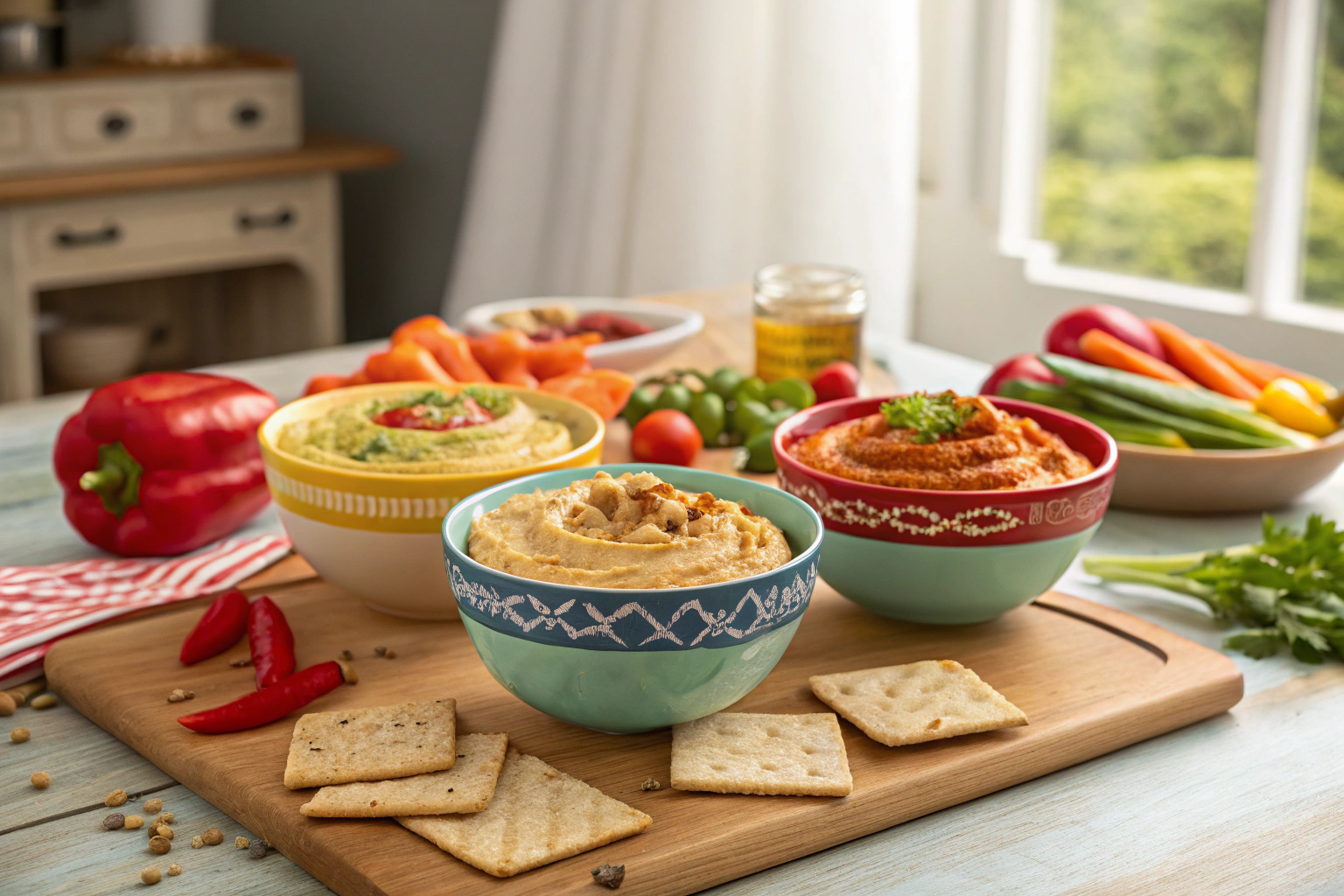Table of Contents
The Story & Intro – My Gluten-Free Hummus Trio Journey
A Family Table in NYC, Rooted in Heritage
Gluten-free hummus isn’t just a trend for our family—it’s a staple. I’m Imma, and our New York kitchen is a true blend of cultures. My Polish husband, Marek, adores hummus just as much as I do. Our daughter Emily, already a tiny whisk-wielder, loves dipping her veggies while her stuffed animals “sample” each new batch. Even my mother Elizabeth, who once swore by traditional Greek spreads, now claims my hummus rivals the ones she grew up with on Kalymnos.
When Emily was diagnosed with a gluten sensitivity, our approach to snacks changed overnight. Suddenly, “safe” meant checking every label, double-checking every recipe, and saying no to anything suspicious. Hummus, made from chickpeas, tahini, lemon, and olive oil, was already a family favorite. But could it really be gluten-free every time? That’s when I dove into researching brands, experimenting with flavors, and crafting our own trio at home—classic, roasted red pepper, and Moroccan-spiced.
This gluten-free hummus trio now stars at every family gathering. I still picture my yiayia’s flour-dusted hands rolling filo, but I’ve swapped wheat for chickpeas, keeping the spirit of togetherness alive. Food is memory, and hummus is our way to stay connected—no matter what dietary twists come our way. With a focus on gluten-free hummus, you can keep everyone at your table safe, happy, and asking for more.
Why Gluten-Free Hummus Matters
Hummus is naturally gluten-free, but cross-contamination or hidden additives can surprise you. That’s why I’m sharing everything I’ve learned—so you can enjoy the creamy, flavorful dips you love without worry. In this article, “gluten-free hummus” isn’t just a keyword; it’s a promise of comfort, safety, and vibrant flavors for every home cook.
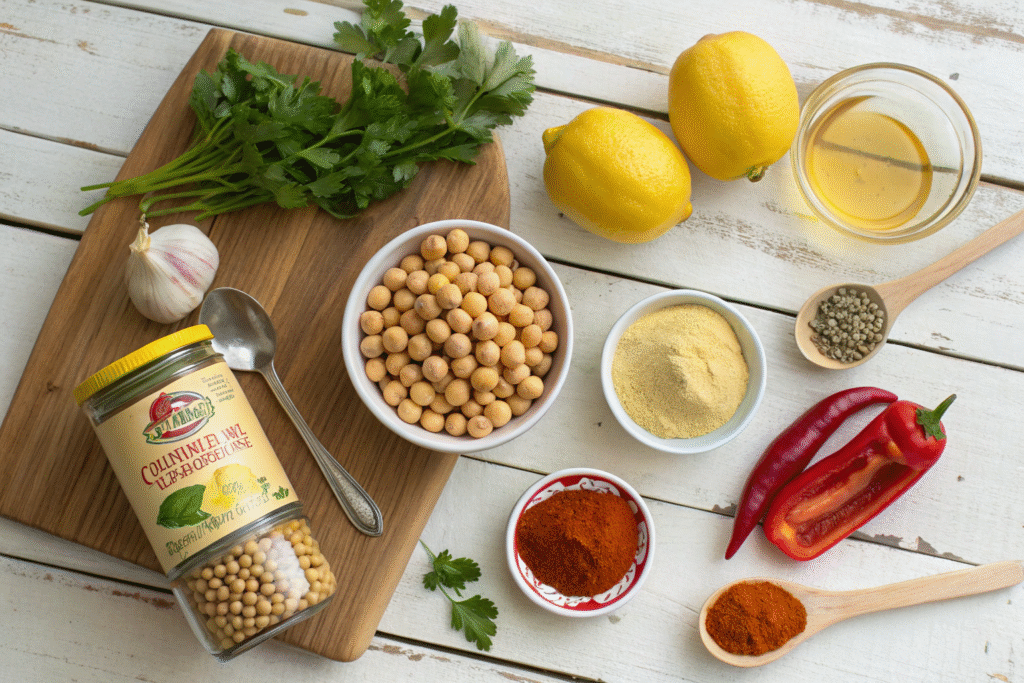
Gluten-Free Hummus Brands and Shopping Tips
How to Choose Gluten-Free Hummus Brands You Can Trust
Shopping for gluten-free hummus can be both simple and confusing. Most traditional hummus is naturally gluten-free, made with basic ingredients like chickpeas, tahini, olive oil, garlic, and lemon juice. But as soon as you wander into the world of flavored hummus and ready-made dips, things get tricky. Some brands add flavorings or preservatives that can contain gluten, or their manufacturing facilities process wheat products, leading to cross-contamination.
Over the years, our family has developed a shortlist of go-to gluten-free hummus brands. Sabra is widely available and labels most of its varieties gluten-free, making it a safe and reliable choice. We also love Hope Hummus, which is certified gluten-free and comes in adventurous flavors like Thai coconut curry and spicy avocado. Ithaca Hummus is another favorite, offering clean, simple recipes and bold twists like lemon beet and buffalo ranch—all gluten-free.
Tribe and Cedar’s brands also deserve a shout-out. Tribe’s packaging notes which flavors are gluten-free (most are), while Cedar’s clearly marks its products and has a fun Moroccan hummus that brings new life to your appetizer plate. At health food stores, you’ll often find local or small-batch hummus brands—many of which are gluten-free—but always double-check their labels or ask staff if you’re unsure.
Tips for Reading Labels and Shopping Confidently
Never assume all hummus is gluten-free just because the main ingredients should be safe. Always read the label, especially with flavors that sound unusual or contain add-ins (like “pizza,” “buffalo,” or “pretzel dip”). Watch for certifications—“Certified Gluten-Free” offers peace of mind for anyone with celiac disease or strong gluten sensitivities. If a package says “manufactured in a facility that processes wheat,” you’ll need to decide based on your sensitivity level. In our family, we play it safe and stick to brands that are transparent about allergens.
Whole Foods, Trader Joe’s, and Aldi all carry private-label hummus, most of which is gluten-free and clearly labeled. Some stores even list gluten-free options on their website, making planning ahead a breeze. When in doubt, don’t hesitate to ask staff or check the company’s website for allergen details.
Quick Takeaways for Gluten-Free Hummus Shopping:
- Read every label, even for familiar brands
- Choose products with a “Certified Gluten-Free” seal when possible
- Beware of flavored or “fusion” hummus with extra add-ins
- Ask staff for help if you’re ever unsure about a product
Our approach is simple: if a hummus brand is open about their ingredients and labeling, they’re worth your trust. With a little care, you can fill your fridge with delicious, worry-free dips for every occasion.
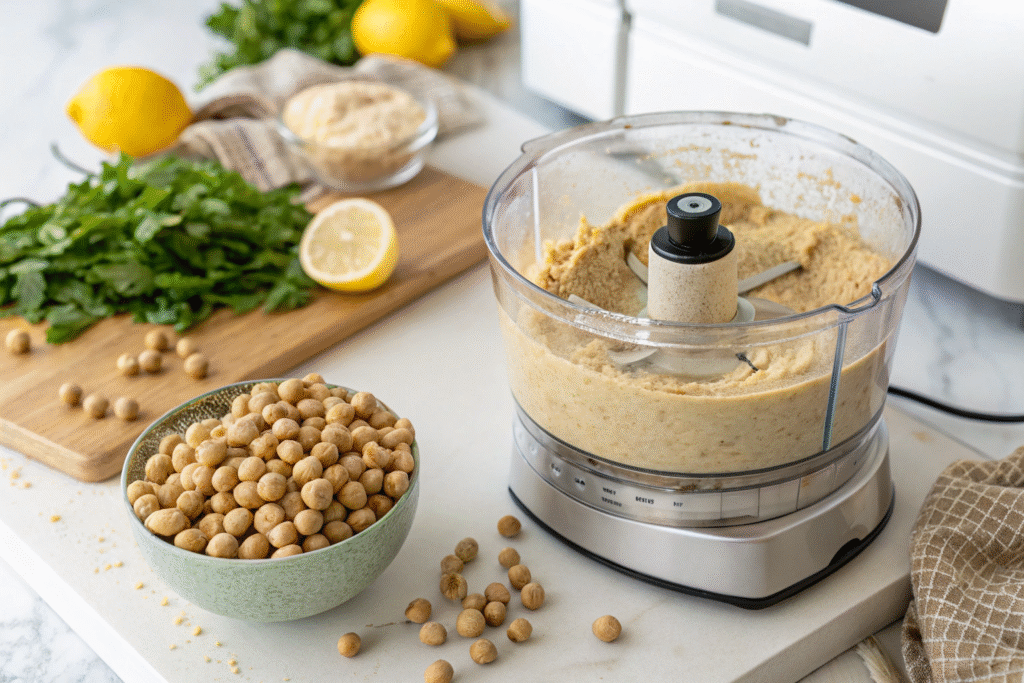
Exploring Hummus Varieties – Is Moroccan Hummus Gluten-Free?
Moroccan Hummus: A Flavorful Gluten-Free Twist
One of the best parts about hummus is how easily it adapts to global flavors. In our kitchen, the “Moroccan” version is always the first to vanish. But is Moroccan hummus gluten-free? The answer is yes—when you stick to the basics.
Moroccan hummus usually features spices like cumin, coriander, smoked paprika, and sometimes a touch of harissa or preserved lemon. These ingredients are naturally gluten-free, so homemade Moroccan hummus is a safe bet for anyone avoiding gluten. In our family, we whip up this version with chickpeas, tahini, lemon, garlic, olive oil, and that signature mix of North African spices. The result is a vibrant, slightly smoky dip with a touch of heat.
But what if you’re buying it pre-made? That’s where it gets important to pay close attention to the label. Most store-bought Moroccan hummus brands—like Cedar’s or Hope—are labeled gluten-free, but some versions (especially those found at gourmet or Mediterranean specialty shops) might include wheat-based thickeners or be made in facilities that handle wheat. If you’re ordering at a restaurant, always ask if their Moroccan hummus is prepared without gluten ingredients or cross-contact.
Key Takeaways:
- Traditional Moroccan hummus is gluten-free by nature.
- Watch out for commercial or restaurant versions that might add gluten-containing ingredients for texture or flavor.
- Always check the packaging or ask about prep methods if you have celiac disease or a severe sensitivity.
Other Fun Gluten-Free Hummus Varieties
Beyond classic and Moroccan, you’ll find an entire world of hummus options. Roasted red pepper, lemon-dill, spicy jalapeño, and even beet or edamame hummus can all be gluten-free—as long as the ingredient list checks out. Our favorite “trio” to serve guests includes:
- Classic hummus, brightened with extra lemon and garlic
- Moroccan spiced hummus, with smoked paprika and cumin
- Roasted red pepper hummus, naturally sweet and creamy
All of these can be made at home with simple, gluten-free ingredients. They pair beautifully with crunchy veggies, gluten-free crackers, or even slices of grilled gluten-free pita. Homemade means total control over what goes in—no worrying about hidden wheat or gluten surprises.
How to Serve Your Gluten-Free Hummus Trio
When we put out our hummus trio for friends and family, it’s always a conversation starter. Serve each flavor in its own bowl, topped with a drizzle of olive oil, fresh herbs, or a sprinkle of dukkah (just make sure your dukkah is gluten-free). Surround with carrot sticks, cucumber, radish, gluten-free pita chips, or your favorite seed crackers for a platter everyone can enjoy.
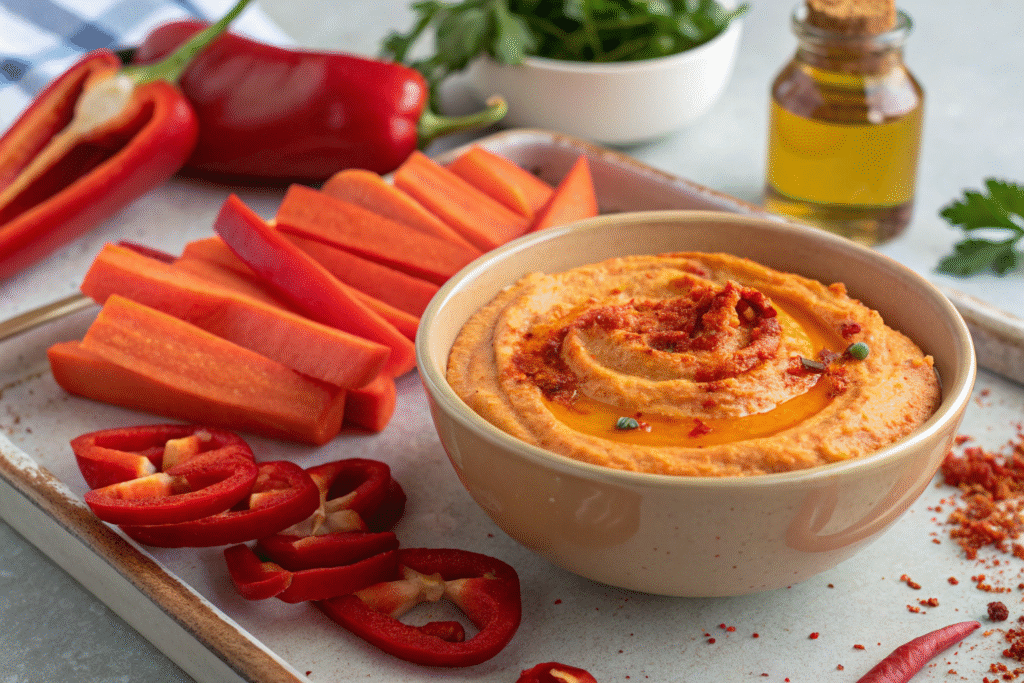
Can I Eat Hummus If I’m Gluten-Free? – Tips for Staying Safe
Hummus and a Gluten-Free Diet: The Essentials
For anyone who needs to avoid gluten—whether for celiac disease, gluten sensitivity, or personal preference—hummus can be a lifesaver. But can you really eat hummus if you’re gluten-free? The short answer: absolutely, as long as you’re aware of the few potential pitfalls.
Pure, homemade hummus is made from naturally gluten-free ingredients: chickpeas, tahini, olive oil, lemon juice, garlic, and salt. If you’re making it at home, you control everything that goes in, making it the safest bet for anyone on a strict gluten-free diet. The only risk comes from what you serve with it—so stick with gluten-free crackers, fresh vegetables, or homemade gluten-free pita to keep things worry-free.
When Store-Bought or Restaurant Hummus Isn’t Always Safe
The biggest risk with hummus and gluten comes from commercial processing or cross-contact. Some brands may use additives, flavorings, or thickening agents that contain gluten. Additionally, if a facility produces other wheat-based foods, cross-contamination can happen. In restaurants, shared kitchen equipment (like blenders or spatulas) can also be a source of hidden gluten.
Here’s how to protect yourself:
- Read every label, even on “classic” hummus.
- Choose brands certified gluten-free or that have strong allergen controls.
- At restaurants, ask staff how the hummus is prepared and if there’s any risk of cross-contact with gluten.
- Watch out for flavored hummus with unexpected add-ins, like “pizza” or “pretzel” varieties.
Gluten-Free Hummus: Enjoy Without Worry
In our house, hummus is a regular guest at the table—spread on sandwiches, spooned onto salads, or simply scooped up with veggies. With a little care, it’s an easy, healthy, and deeply satisfying gluten-free option for snacks and meals. Whether you’re hosting friends or packing lunches, gluten-free hummus will always deliver flavor and comfort, bringing people together around the table.
Print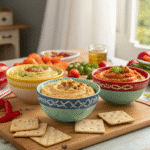
Gluten-Free Hummus
- Total Time: 10 minutes
- Yield: 3 bowls (serves 6-8 as an appetizer) 1x
Description
A creamy, vibrant gluten-free hummus trio inspired by family tradition—classic, roasted red pepper, and Moroccan-spiced—perfect for sharing at any gathering.
Ingredients
- 1 (15 oz) can chickpeas, drained and rinsed
- 1/4 cup tahini
- 3 tbsp fresh lemon juice
- 2–3 tbsp olive oil, plus more for serving
- 2 cloves garlic, minced
- 1/2 tsp sea salt
- 2–3 tbsp cold water (as needed)
- 1/2 tsp ground cumin (for classic)
- 1/2 tsp smoked paprika (for Moroccan)
- 1/2 tsp ground coriander (for Moroccan)
- 1 tsp harissa or 1/2 preserved lemon (optional, for Moroccan)
- 1/3 cup roasted red peppers, chopped (for roasted red pepper version)
- Fresh herbs (parsley, cilantro) for garnish
- Optional toppings: gluten-free dukkah, more olive oil
Instructions
- For the classic hummus: In a food processor, blend chickpeas, tahini, lemon juice, olive oil, garlic, sea salt, cumin, and 2 tbsp water until smooth and creamy. Add more water for a thinner consistency if needed.
- For the Moroccan hummus: Scoop half the classic hummus into a bowl. To the remaining hummus in the processor, add smoked paprika, coriander, and harissa or preserved lemon if using. Blend to combine.
- For the roasted red pepper hummus: Scoop another portion of classic hummus into a bowl. To the remaining base, add roasted red peppers and blend until smooth and vibrant.
- Spoon each hummus flavor into separate bowls. Drizzle with olive oil and sprinkle with fresh herbs or gluten-free dukkah if desired.
- Serve with carrot sticks, cucumber slices, radish, gluten-free pita chips, or your favorite gluten-free crackers. Enjoy!
Notes
Always check your tahini and spices for gluten-free certification. For extra creamy hummus, peel the chickpeas before blending. Customize spices to taste, and feel free to swap in other gluten-free add-ins like lemon zest, beets, or jalapeño for more variety.
- Prep Time: 10 minutes
- Cook Time: 0 minutes
- Category: Appetizer
- Method: No-Cook
- Cuisine: Mediterranean
Nutrition
- Serving Size: About 1/4 cup
- Calories: 110
- Sugar: 1g
- Sodium: 160mg
- Fat: 7g
- Saturated Fat: 1g
- Unsaturated Fat: 6g
- Trans Fat: 0g
- Carbohydrates: 8g
- Fiber: 2g
- Protein: 3g
- Cholesterol: 0mg
FAQ Section
Which hummus brands are gluten-free?
Many brands are gluten-free, but Sabra, Hope, Ithaca, Tribe, and Cedar’s are reliable choices. Always check for “certified gluten-free” on the label.
Is Moroccan hummus gluten-free?
Yes—traditional Moroccan hummus is naturally gluten-free. Always check labels or ask about preparation if buying premade or ordering at restaurants
Can I eat hummus if I’m gluten-free?
Absolutely! Hummus is naturally gluten-free, but always read labels and watch for cross-contact when buying or eating out.
Is just hummus gluten free?
Pure, classic hummus made with chickpeas, tahini, lemon juice, and olive oil is gluten-free. Just watch for added flavors or wheat-based thickeners in processed products.
Conclusion
Gluten-free hummus is more than a safe snack—it’s a way to gather, share, and connect around the table. Whether you’re reaching for trusted store-bought brands or making a trio of homemade dips, you can enjoy every bite without worry. By reading labels, staying curious, and asking questions, you’ll keep your snacks both delicious and safe—ensuring that everyone, no matter their dietary needs, feels right at home in your kitchen.
👉 I hope you loved serving up this Gluten-Free Hummus Trio—it’s creamy, vibrant, and the ultimate crowd-pleaser for any party, potluck, or healthy snack time!
Craving more gluten-free goodness? Try our Gluten-Free Greek Quinoa Salad for another fresh and wholesome dish that pairs beautifully with your hummus spread. For an easy and sweet finish to your meal, our No-Bake Chocolate Chip Cookie Dough Bars are always a hit.
Don’t miss our Strawberry Cheesecake Bites, a delightful treat that’s perfect for rounding out your gluten-free feast.
If you’re on the hunt for more inspiration, take a peek at Quinoa Salad on SANTMD—a fantastic veggie-packed option for gluten-free eaters. Or check out their Grain Bowl Recipe for a hearty lunch idea.
Over on Danarecipes, you might enjoy their Vegan Walnut Pate Faux Gras—a unique plant-based dip perfect for your next snack board.
Feel free to join us on our Facebook Page and Facebook Group for daily updates and recipe swaps with other foodies. And don’t forget to check out our Pinterest for even more gluten-free, cozy recipe ideas!

